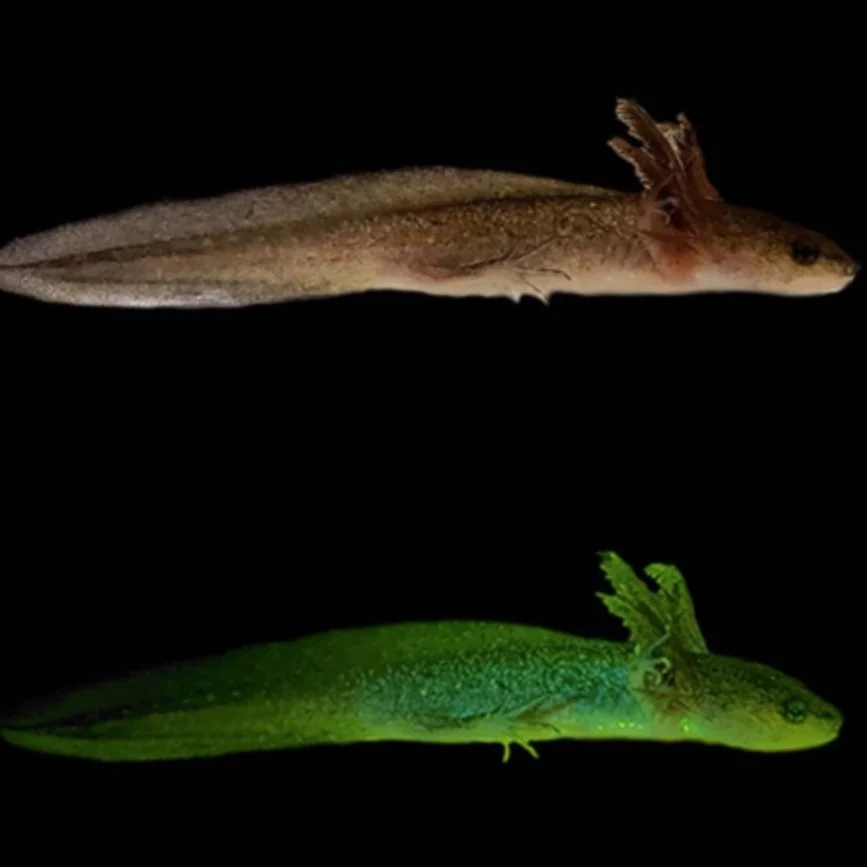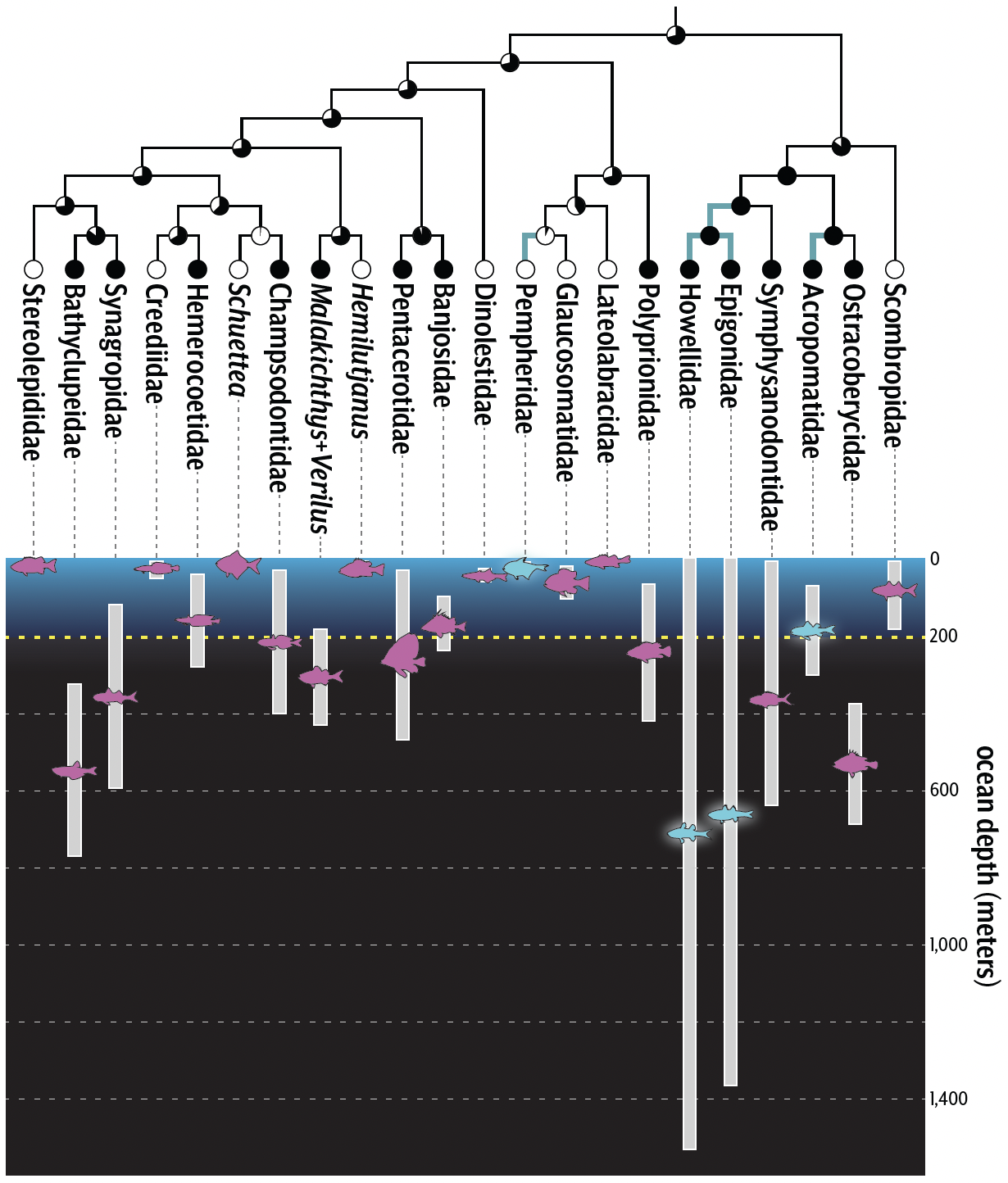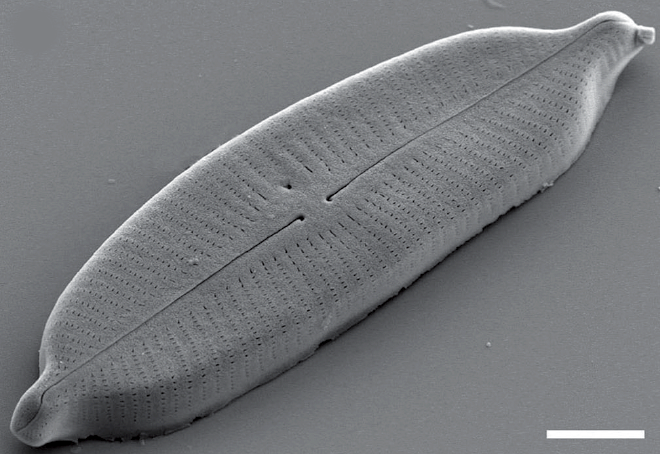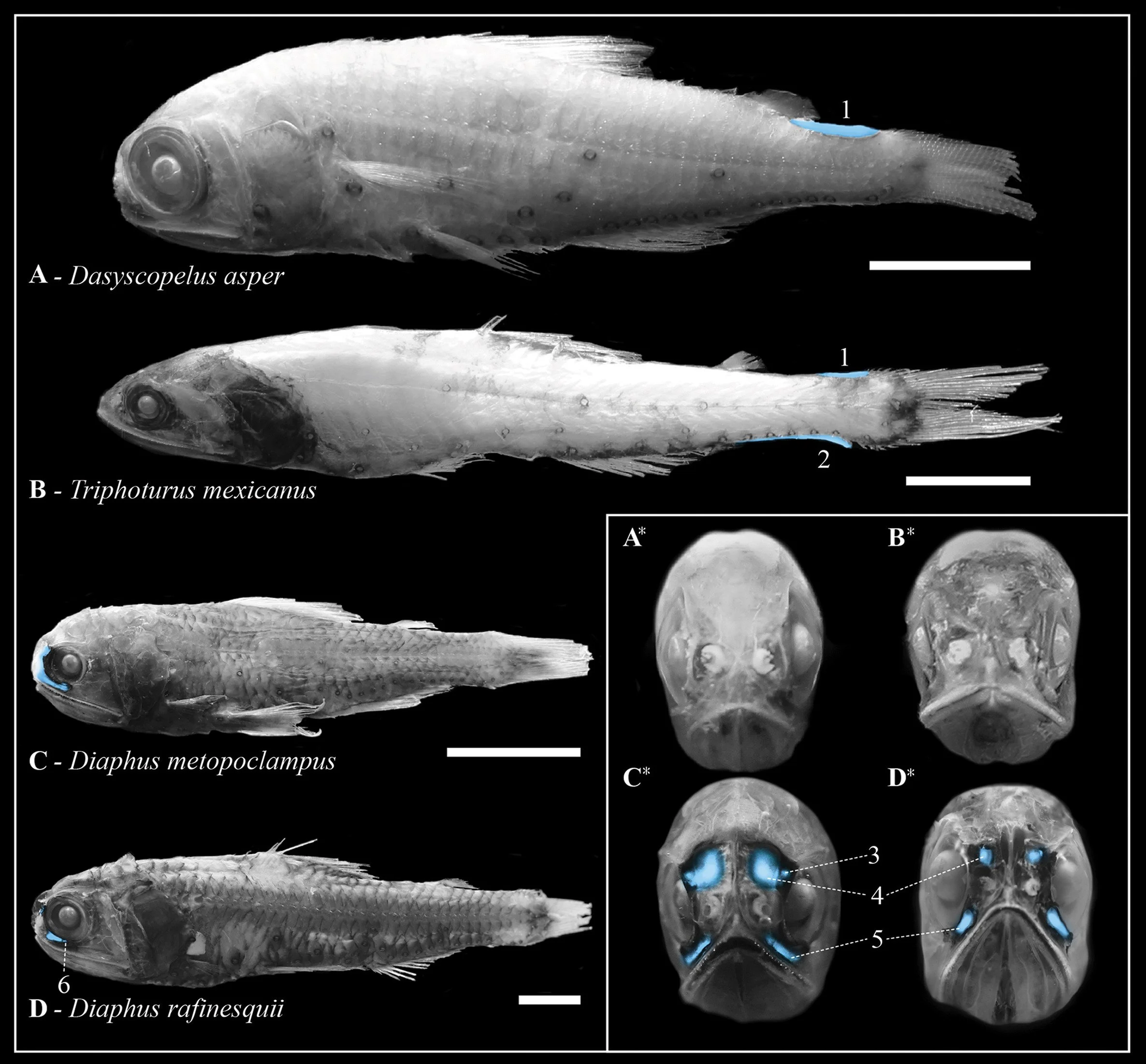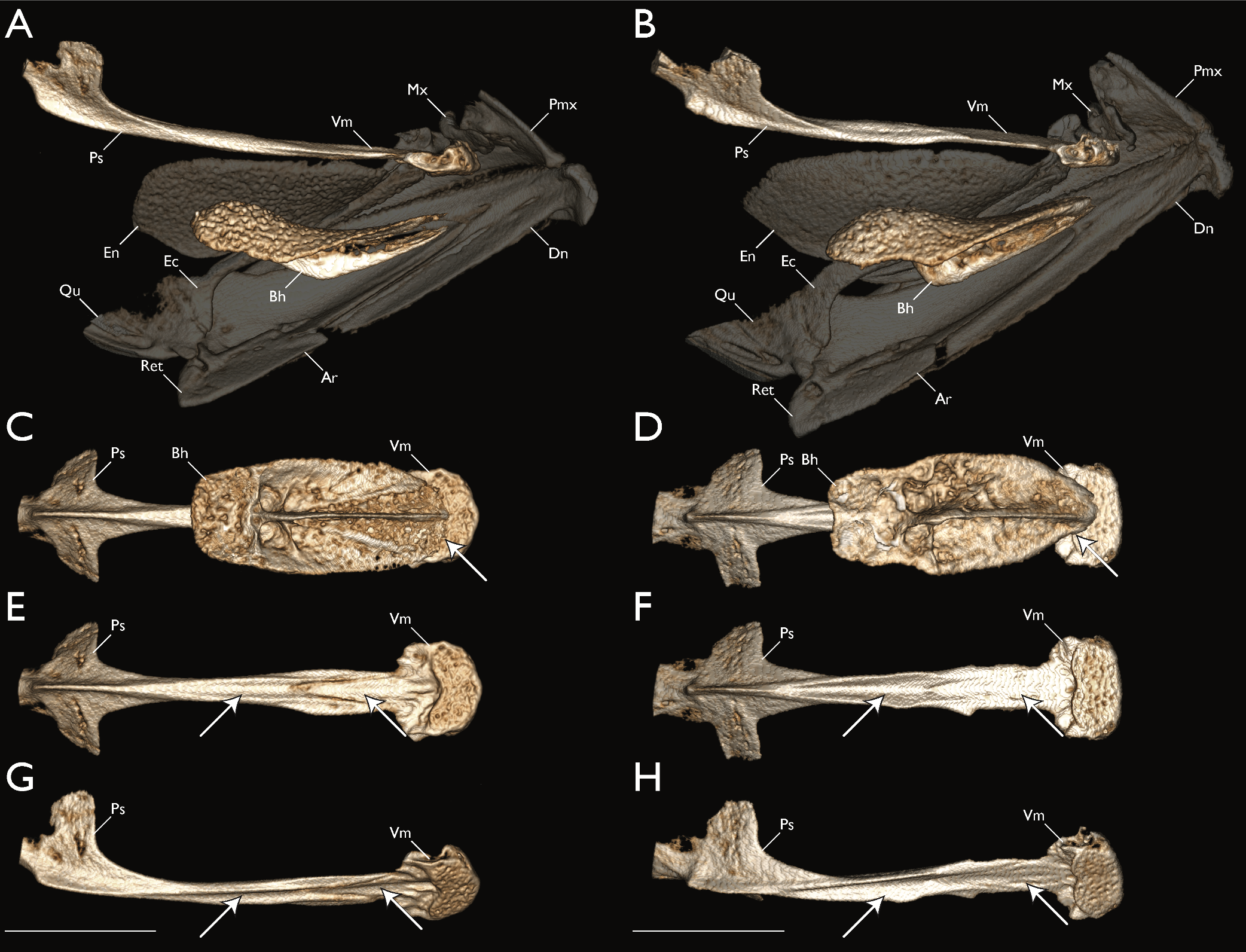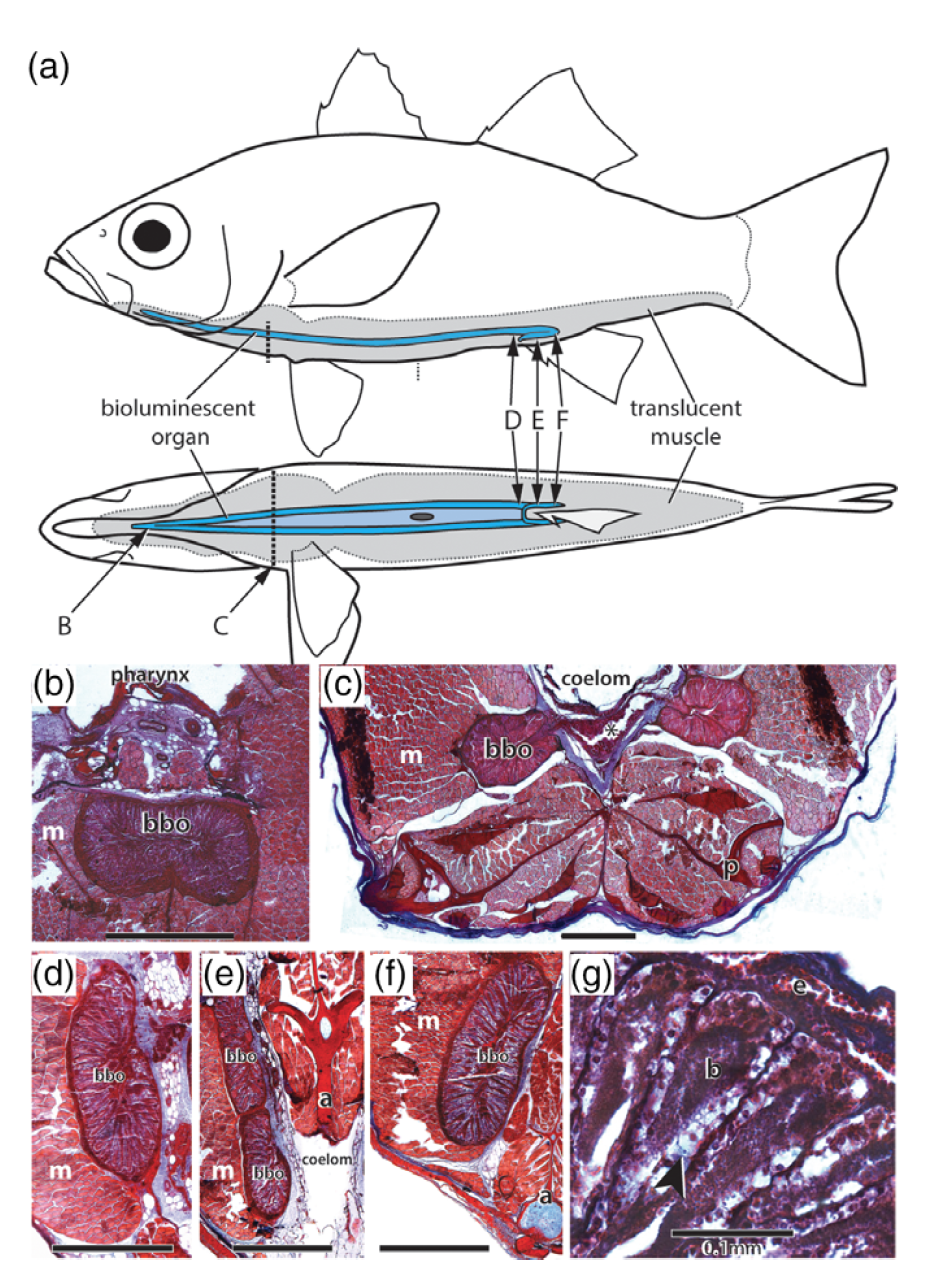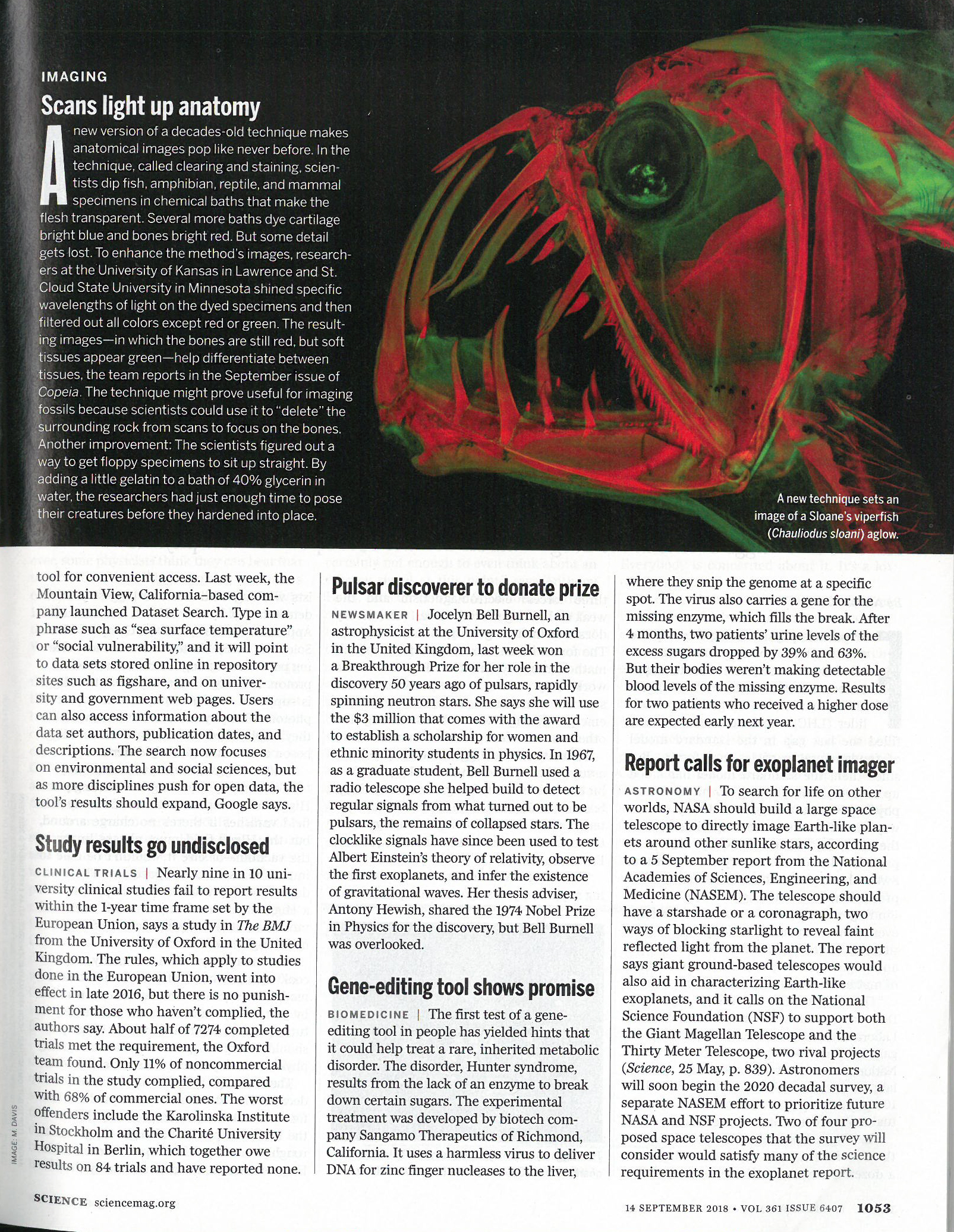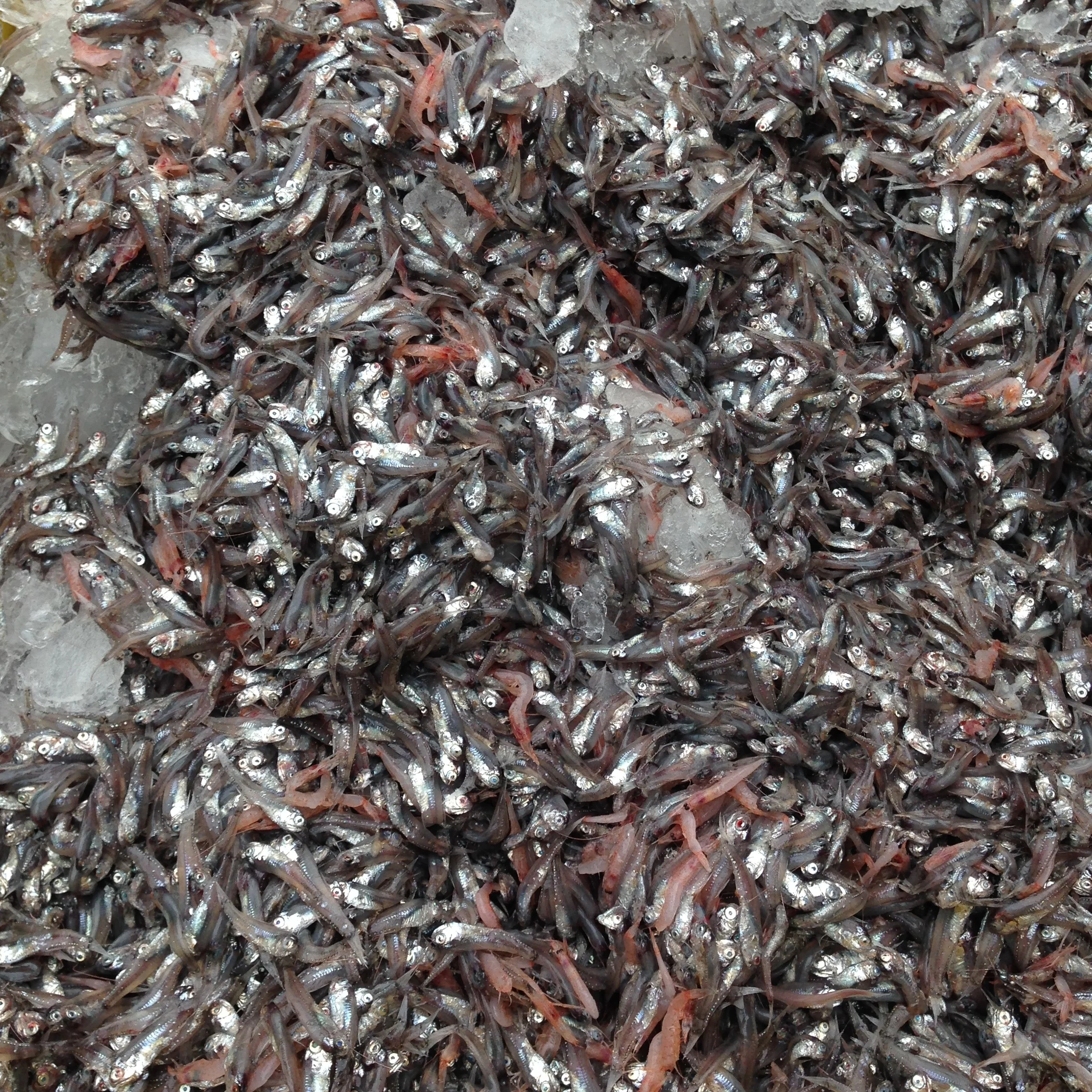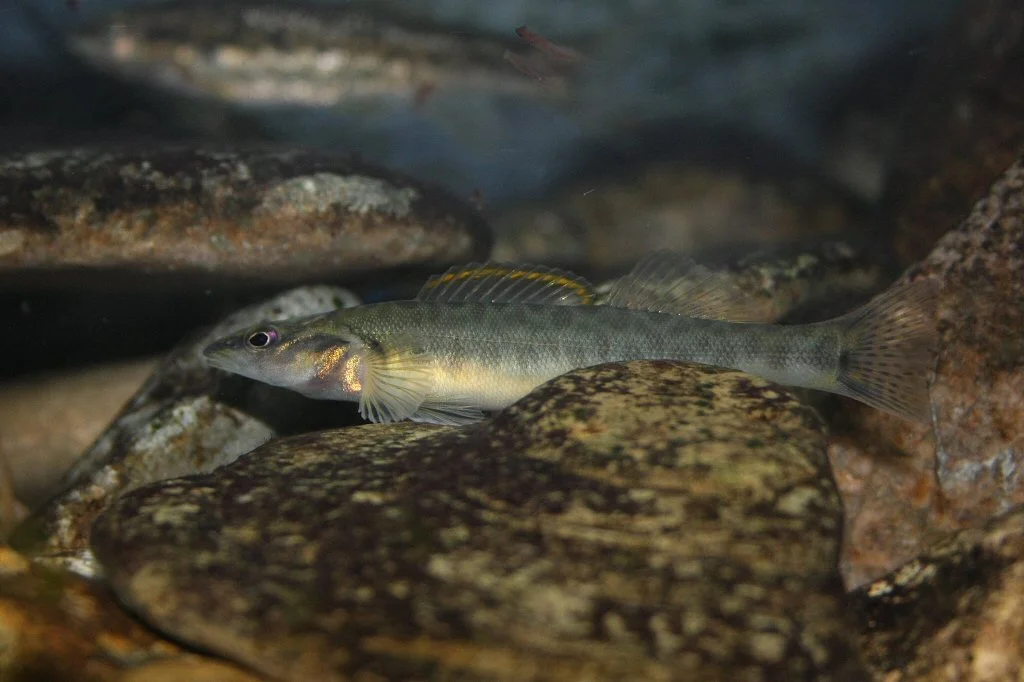Publications
Evolution of Anglerfishes
43. Maile, A.J., Smith, W.L., and Davis, M.P. (2025). A total-evidence phylogenetic approach to understanding the evolution, depth transitions, and body-shape changes in the anglerfishes and allies (Acanthuriformes: Lophioidei). PloS one 20 (5), e0322369
Glowing Salamander Larvae
42. Lamb, J.Y., Cooper, H., Seymour, A., Davis, M.P., and Beaty, L. (2025). Illuminating the Early Life of Salamanders: Exploring Biofluorescence During Development. Ichthyology & Herpetology, 113(1):104-116. https://doi.org/10.1643/h2024080
Novel Relationships and Revised Classification of the Dragonfishes (Stomiiformes)
41. Smith, W.L., Girard, M.G., Walker, H.J., and Davis, M.P. (2024). The phylogeny of bristlemouths, lightfishes, and portholefishes with a revised family-level classification of the dragonfishes (Teleostei: Stomiiformes). In Early Life History and Biology of Marine Fishes: Research inspired by the work of H Geoffrey Moser (J. M. Leis, W. Watson, B. C. Mundy, and P. Konstantinidis, guest eds.), p. 167–184. NOAA Professional Paper NMFS 24. https://doi.org/10.7755/PP.24.13
Investigation into the Grape-eye Seabass (Hemilutjanus macrophthalmos) Rewrites the Evolutionary History of Acropomatiformes
40. Smith, W.L., Ghedotti, M.J., Domínguez-Domínguez, O., McMahan, C.D., Espinoza, E., Martin, R.P., Girard, M.G., and Davis, M.P. (2022). Investigations into the ancestry of the Grape-eye Seabass (Hemilutjanus macrophthalmos) reveal novel limits and relationships for the Acropomatiformes (Teleostei: Percomorpha). Neotropical Ichthyology. https://doi.org/10.1590/1982-0224-2021-0160
Structure and Evolutionary History of an Enigmatic Diatom
39. Yana, E., Nakkaew, S., Pekkoh, J., Peerapornpisal, Y., Tuji, A., Davis, M.P., Julius, M.L., and Mayama, S.. (2022). Valve and ‘Stigma’ Structure and Phylogeny of an Enigmatic Cymbelloid Diatom Karthickia verestigmata Glushchenko, Kulikovskiy & Kociolek. Diatom Research. https://doi.org/10.1080/0269249X.2022.2101545
Impacts of Glowing Organs on Body-Shape Evolution in the Deep Sea
38. Martin, R.P., Davis, M.P., and Smith, W.L. (2022). The impact of evolutionary trade-offs among bioluminescent organs and body shape in the deep sea: A case study on lanternfishes. Deep Sea Research Part I: Oceanographic Research Papers. https://doi.org/10.1016/j.dsr.2022.103769
Evolution of Archerfish Shooting Apparatus
37. Girard, M.G., Davis, M.P., Tan, H.H., Wedd, D.J., Chakrabarty, P., Ludt, W.B., Summers, A.P., and Smith, W.L. (2022). Phylogenetics of archerfishes (Toxotidae) and evolution of the toxotid shooting apparatus. Integrative Organismal Biology, obac013, https://doi.org/10.1093/iob/obac013
Popular Press:
Inner ‘blowpipe’ explains how archerfish spit water with such deadly force - Science
The archerfishes sharp-shooting skills have puzzled scientists. A study may have the answers. - MSN
How did the archerfish learn to shoot down their prey? A new study has an idea. - NBC News
Evolution of Threadfins!
36. Girard, M.G., Davis, M.P., Baldwin, C.C., Dettai, A., Martin, R.P., and Smith, W.L. (2022). Molecular phylogeny of the threadfin fishes (Polynemidae) using ultraconserved elements. Journal of Fish Biology. DOI: http://doi.org/10.1111/jfb.14997
Bioluminescent Slimeheads!
35. Ghedotti, M.J., DeKay, H.M., Maile, A.J., Smith, W.L., and Davis, M.P. (2021). Anatomy and evolution of bioluminescent organs in the slimeheads (Teleostei: Trachichthyidae). Journal of Morphology. DOI: https://doi.org/10.1002/jmor.21349
Marine Habitat Transitions and Body-Shape Evolution in Lizardfishes
34. Maile, A.J., May, Z.A., DeArmon, E.S., Martin, R.P., and Davis, M.P. (2020). Marine Habitat Transitions and Body-Shape Evolution in Lizardfishes and Their Allies (Aulopiformes). Copeia(4):820-832 (2020). DOI: https://doi.org/10.1643/CG-19-300
Awarded Best Student Paper in Ichthyology in Ichthyology and Herpetology (Copeia 2020) by the American Society of Ichthyologists and Herpetologists.
Livebearers of North America
33. Ghedotti, M.J., Davis, M.P., and Echelle, A.F. (2020). Poeciliidae: Livebearers. In Freshwater Fishes of North America: Volume 2. Editors: Warren, M.L., Burr, B.M., Echelle, A.A., Kuhajda, B.R., and Ross, S.T.
Phylogeny of Carangiform Fishes
32. Girard, M.G., Davis, M.P., and Smith, W.L. (2020). The Phylogeny of Carangiform Fishes: Morphological and Genomic Investigations of a New Fish Clade. Copeia 108(2):265-298 (2020). DOI: https://doi.org/10.1643/CI-19-320
Hunting with hooked teeth in the deep sea!
31. Martin, R.P. and Davis, M.P. (2020). The evolution of specialized dentition in the deep‐sea lanternfishes (Myctophiformes). Journal of Morphology. DOI: https://doi.org/10.1002/jmor.21120
Fluorescing frogs and neon newts!
30. Lamb, J.Y. and Davis, M.P. (2020). Salamanders and other amphibians are aglow with biofluorescence. Scientific Reports. DOI: 10.1038/s41598-020-59528-9.
Nature Ecology and Evolution Behind the Paper: Fluorescing frogs and neon newts.
TEDx Talk: The Glowing Creatures Hidden in Your Backyard.
Popular Press
Klein, J. New York Times. “Amphibians Have Been Hiding a Glowing Secret From Us”
Ortega, R.P. Science. “Newts and frogs light up like glow sticks under the right light”
Pappas, S. Scientific American. "Salamanders and Frogs Light Up with Secret Superpower"
Nemo, L. Discover Magazine. “Glow-in-the-Dark Amphibians Are Way More Common Than Scientists Thought”
Garcia de Jesus, E. Science News. “Glowing frogs and salamanders may be surprisingly common”
Crane, L. New Scientist. “It turns out loads of frogs and salamanders are fluorescent”
Lewis, S. CBS NEWS. “Amphibians are able to glow in the dark — but scientists had no idea until now”
Long, K. Mental Floss. "It’s Easy Being Green: Most Amphibians Are Biofluorescent, Study Finds"
Simon, M. Wired. “So, Amphibians Glow. Humans Just Couldn't See It—Until Now”
Chadwick, J. Dail Mail. “Glowing FROGS may be more common that previously thought as scientists claim biofluorescence may help amphibians find each other in the dark or hide from predators”
Speier, T. University Chronicle. “Biology department is ‘aglow’ with recent findings”
McClenaghan, S. EurekAlert!. “Zoology: Biofluorescence may be widespread among amphibians”
Pulano, N. Inverse. “AMPHIBIANS MAY SHARE A BIZARRE TRAIT THAT LETS THEM SEE IN THE DARK — STUDY”
The first evidence of intrinsic epidermal bioluminescence within ray‐finned fishes
29. Ghedotti, M.J., Smith, W.L., and Davis, M.P. (2019). The first evidence of intrinsic epidermal bioluminescence within ray‐finned fishes in the linebelly swallower Pseudoscopelus sagamianus (Chiasmodontidae). Journal of Fish Biology.
Morphology of bioluminescent organs and evolutionary relationships among the glowbellies and their allies (Percomorpha: Acropomatidae)
28. Ghedotti, M.J., Gruber, J.N., Barton, R.W., Davis, M.P., and Smith, W.L. (2018). Morphology and evolution of bioluminescent organs in the glowbellies (Percomorpha: Acropomatidae) with comments on the taxonomy and phylogeny of Acropomatiformes. Journal of Morphology.
Improving Vertebrate Skelton Imaging
27. Smith, W.L., Buck C.A., Ornay G.S., Davis M.P., Martin R.P., Gibson S.Z., and Girard M.G. (2018). Improving Vertebrate Skeleton Images: Fluorescence and the Non-Permanent Mounting of Cleared-and-Stained Specimens. Copeia 106(3):427-435.
Popular Press
Jones, M. National Geographic. “Skeleton Photos are Getting a Boost with the help of Gelatin.”
Supriya, L. Science. “These eerie new images reveal the insides of fish and snakes like never before.”
Becker, R. The Verge. "How scientists captured a stunning, hellish menagerie of half-dissolved creatures."
Kotecki, P. Business Insider. “These haunting photos of vertebrate skeletons were created using an ultra-detailed new imaging method.”
Starr, M. Science Alert. "These Hauntingly Beautiful Images Reveal an Unseen World Beneath Vertebrates' Skin."
Furness, D. Digital Trends. “These haunting anatomical images turn vertebrates inside out.”
Stang, C. St. Cloud State Today. "Biologists monsters are works of art."
Guterman, L. Science. “Scans light up anatomy.” September 14th, 2018 (Print Magazine)
Evolutionary Relationships and Revised Classification of Lanternfishes
26. Martin, R.P., Olson, E.E., Girard, M.G., Smith, W.L., and Davis, M.P. (2018). Light in the Darkness: New Perspective on Lanternfish Relationships and Classification Using Genomic and Morphological Data. Molecular Phylogenetics & Evolution.
Evolution of Extinct and Living Topminnows
25. Ghedotti, M.J., and Davis, M.P. (2017). The taxonomic placement of three fossil Fundulus species and the timing of divergence within the North American topminnows (Teleostei: Fundulidae). Zootaxa. 4250 (6): 577–586.
Evolution of Mouth Size in Deep-sea Lanternfishes
24. Martin, R.P., and Davis, M.P. (2016). Patterns of Phenotypic Variation in the Mouth Size of Lanternfishes (Teleostei: Myctophiformes). Copeia. 104(4):795-807.
Evolution of Venom in Fishes
23. Smith, W.L., Stern, J.H., Girard, M.G., and Davis, M.P. (2016). Evolution of Venomous Cartilaginous and Ray-Finned Fishes. Integrative and Comparative Biology. doi: 10.1093/icb/icw070
Popular Press
Blaszczak-Boxe, A. Live Science. "Fish Venom Unveiled: Toxins Evolved Many Times, Study Shows."
Lynch, B. EurekAlert! "Researchers tally huge number of venomous fishes, tout potential for medical therapies."
de Lazaro, E. Sci News. "Study Finds Venom Has Evolved 18 Times in Marine and Freshwater Fishes."
Hays, B. UPI. "Study: Venomous fish could be repository of medicinal compounds."
Evolution of Bioluminescence in Fishes
22. Davis, M.P., Sparks, J.S., and Smith, W.L. (2016). Repeated and Widespread Evolution of Bioluminescence in Marine Fishes. PLOS ONE. 11(6): e0155154.
Popular Press
Douglass, M. BBC Earth. "The Ocean is a Strange Place at Night."
Yong, E. National Geographic. "Surprising History of Glowing Fish."
Netburn, D. LA Times. "Bioluminescence is so useful to fish that it evolved 27 times, study says."
Frazer, J. Scientific American. "Eighty Percent of Open Ocean Fish Make Light."
Ash, C. Science (22 Jul 2016: Vol. 353, Issue 6297, pp. 360). "How fish evolved an abyssal glow."
Harvey, C. Mashable. "There are Far More Glowing Fish in the Sea Than Previously Known."
Nuwer, R. Smithsonian Magazine. "Way More Fish Can Make Their Own Light Than We Thought."
Newitz, A. Ars Technica. "Evolution favors the bioluminescent."
Bates, M. PLOS Ecology Community. "The Oceans are Aglow With Light-Up Fishes."
Weisberger, M. Live Science. "Flash Mob! Glowing in Fishes More Widespread Than Thought." Image Gallery
Feltman, R. The Washington Post. "Glow-in-the-Dark Fish Have Evolved Over and Over Again."
Kuhr, M. Newsweek. "Bioluminescence is Spreading to New Fish Species."
Lewis, T. The Scientist. "Evolution of Fish Bioluminescence."
Sierra, C. Pulse Headlines. "Glowing deep ocean fishes have evolved at least 27 times."
Navarro, A. Tech Times. "Glow-in-the-dark Ocean Fish Are More Widespread Than Known."
PLOS. EurekAlert! "New research shines light on evolutionary variety of bioluminescent ocean fishes."
AMNH. News and Blogs. "Bioluminescence Evolved Frequently in Fish."
Scalise, J. Science Recorder. "Bioluminescence More Common than Previously Believed."
Best, S. Daily Mail. "Glow-in-the-dark fish are more common than thought: Bioluminescence is so useful in oceans it evolved 27 times."
Davis, J. IFLScience!. "Bioluminescence In Fish Is Far More Widespread Than Previously Thought."
Visualization of Biofluorescence in Sharks
21. Gruber, D.F., Loew, E.R., Deheyn, D.D., Akkaynak, D., Gaffney, J.P., Smith, W.L., Davis, M.P., Stern, J.H., Pieribone, V.A., and Sparks, J.S. (2016). Biofluorescence in Catsharks (Scyliorhinidae): Fundamental Description and Relevance for Elasmobranch Visual Ecology. Scientific Reports. 6, 24751; doi: 10.1038/srep24751
Popular Press
Howard, B.C. National Geographic. "Through a Shark's Eyes: See How They Glow in the Deep."
Preston, E. The Atlantic. "Scientists Have Developed Shark Vision."
Frazer, J. Scientific American. "Cat Sharks Send Secret, Fluorescent Messages."
Ossola, A. Popular Science. "Sharks Glow, But Only For Each Other."
Snyder, K. EurekAlert!. "Patterns of Glowing Sharks Get Clearer with Depth."
Feltman, R. The Washington Post. "Scientists Built a Special Camera to Study Glow-In-The-Dark Sharks."
New Genus of Pearleye from Antarctic Waters
20. Davis, M.P. (2015). Evolutionary Relationships of the Deep-Sea Pearleyes (Aulopiformes: Scopelarchidae) and a New Genus of Pearleye from Antarctic Waters. Copeia. 103(1):64-71.
Bioluminescent Liver Tissue in Deep-sea Barracudinas
19. Ghedotti, M.J., Barton, R.W., Simons, A.M., and Davis, M.P. (2015). The First Report of Luminescent Liver Tissue in Fishes: Evolution and Structure of Bioluminescent Organs in the Deep-Sea Naked Barracudinas (Aulopiformes: Lestidiidae). Journal of Morphology. DOI: 10.1002/jmor.20341
Bioluminescence impacts Diversification in Deep-sea Fishes
18. Davis, M.P., Holcroft, N.I., Wiley, E.O., Sparks, J.S., and Smith, W.L. (2014). Species-Specific Bioluminescence Facilitates Speciation in the Deep Sea. Marine Biology. DOI: 10.1007/s00227-014-2406-x.
Popular Press
Foley, J.A. Nature World News. "Bioluminescence in Deep-Sea Fishes Breeds Species Diversity."
Synder, K. American Museum of Natural History. "Bioluminescent Fish Flashing Patterns Might Facilitate Mating."
Lynch, B. KU News. "Research will shed light upon the family tree of deep-sea fishes."
Survey and Discovery of Biofluorescence across Fishes
17. Sparks, J.S., Schelly, R.C., Smith, W.L., Davis, M.P., Tchernov, D., Pieribone, V., and Gruber, D.F. (2014). The Covert World of Fish Biofluorescence: A Phylogenetically Widespread and Phenotypically Variable Phenomenon. PLOS ONE. 9(1): e83259.
Popular Press
Gorman, J. New York Times. "Fluorescence Is Widespread in Fish, Study Finds."
Netburn, D. LA Times. "Undersea light show: The secret neon world of biofluorescent fish."
Conciatore, J. National Science Foundation (Biological Sciences Discovery). "Fish aglow: Hidden colors in the sea"
Venton, D. Nature News. "Fish flaunt neon glow."
Randall, I. Science Now. "Fish Put on a Light Show."
Lee, J. National Geographic. "Fish Light Up in Neon Colors."
Almasy, S. CNN. "From blue to green, red or orange: Fish put on new light."
Mason, B. Wired. "Scientists Discover 180 Species of Glowing Fish."
Thomas, P. Slate. "Diving Deep with the Ocean's Biofluorescent Fish."
Marash, C. World Science Festival. "Fluorescent Fish Light Up the Deep Blue Sea."
Misra, R. IO9. "These new species of biofluorescent fish are beautifully strange."
Tu, C. Science Friday. "Picture of the Week: Biofluorescing Fish."
Poppick, L. LiveScience. "Glow Fish: Drab Species Secretly Don Bright Colors."
Snyder, K. American Museum of Natural History. "Researchers Reveal Covert World of Fish Biofluorescence."
Evolution and Diversification of Cichlids
16. McMahan, C.D., Chakrabarty, P., Sparks, J.S., Smith, W.L., and Davis, M.P. (2013). Temporal Patterns of Diversification across Global Cichlid Biodiversity (Acanthomorpha: Cichlidae). PLoS ONE. 8(8): e71162.
First Fossil Shellear and Divergence of Milkfishes and their allies
15. Davis, M.P., Arratia, G.A., and Kaiser, T. (2013). The first fossil shellear and its implications for the evolution and divergence of the Kneriidae (Teleostei: Gonorynchiformes). In: Arratia, G.A., Schultze, H.P., and Wilson, M.V.H. (Eds.), Mesozoic Fishes V. München (Verlag Dr. F. Pfeil). PP. 325-362.
Power and Parameter Estimation of the BiSSE Method
14. Davis, M.P., Midford, P.E., and Maddison, W. (2013). Exploring power and parameter estimation of the BiSSE method for analyzing species diversification. BMC Evolutionary Biology. 13:38 DOI: 10.1186/1471-2148-13-38. Highly Accessed.
Evolution of the Killifishes
13. Ghedotti, M.J., and Davis, M.P. (2013). Phylogeny, classification, and evolution of salinity tolerance of the North American topminnows and killifishes, Family Fundulidae (Teleostei: Cyprinodontiformes). Fieldiana: Life and Earth Sciences. 7(2013):1-65.
Phylogeography of the Mountain Mullet
12. McMahan, C.D., Davis, M.P., Dominguez-Dominguez, O., Garcia de Leon, F., Doadrio, I. and K.R. Piller. (2012). From the Mountains to the Sea: Phylogeography and Cryptic Species Diversity within the Mountain Mullet, Agonostomus monticola (Teleostei: Mugilidae). Journal of Biogeography. DOI: 10.1111/jbi.12036.
Biogeography and Evolution of Gobies
11. Chakrabarty, P., Davis, M.P., and Sparks, J.S. (2012). The first record of a trans-oceanic sister-group relationship between obligate vertebrate troglobites. PLoS ONE. 7(8): e44083.
Popular Press
Ball, J. BBC News. "Goby fish 6,000km apart share eyeless common ancestor."
Evolution and Timing of Divergence of Ray-finned Fishes
10. Near, T.J., Eytan, R.I., Dornburg, A., Kuhn, K.L., Moore, J.A., Davis, M.P., Wainwright, P.C., Friedman, M., and Smith, W.L. (2012). Resolution of ray-finned fish phylogeny and timing of diversification. Proceedings of the National Academy of Sciences. 109(34):13698-703.
Popular Press
Real. N. FISHBIO: Fisheries research, monitoring, and conservation. "Ray-finned fishes get new family tree."
Light Organ Evolution in Ponyfishes
09. Chakrabarty, P., Davis, M.P., Smith, W.L., Berquist, R., Gledhill, K.M., Frank, L.R., and Sparks, J.S. (2011). Evolution of the light organ system in ponyfishes (Teleostei: Leiognathidae). Journal of Morphology. (272) 6: 704-721.
Evolution and Diversification of Ponyfishes
08. Chakrabarty, P., Davis, M.P., Smith, W.L., Baldwin, Z., and Sparks, J.S. (2011). Is sexual selection driving diversification of the bioluminescent ponyfishes (Teleostei: Leiognathidae)? Molecular Ecology. (20) 13: 2818-2834.
Debate on Phylogenetic Character Data (Response)
07. Wiley, E.O., Chakrabarty, P., Craig, M.T., Davis, M.P., Holcroft, N.I., Mayden, R.L., and Smith, W.L. (2011). A Response to Mooi, Williams, and Gill. Zootaxa. 2946: 33-37.
Debate on Phylogenetic Character Data
06. Wiley, E.O., Chakrabarty, P., Craig, M.T., Davis, M.P., Holcroft, N.I., Mayden, R.L., and Smith, W.L. (2011). Will the real phylogeneticists please stand up? Zootaxa. 2946: 7-16.
Tripodfish Locomotion
05. Davis, M.P., and Chakrabarty, P. (2011). Tripodfish locomotion and landing behavior (Aulopiformes: Bathypterois) from video observations at bathypelagic depths in the campos basin of Brazil. Marine Biology Research, (7) 3:297-303.
Divergence Time Estimation of Lizardfishes
04. Davis, M.P., and Fielitz, C. (2010). Estimating divergence times of lizardfishes and their allies (Euteleostei: Aulopiformes) and the timing of deep-sea adaptations. Molecular Phylogenetics and Evolution, (57) 3:1194-1208.
Popular Press
Taylor, C. Catalogue of Organisms: An Inordinate Fondness for Systematics. “Hunters in the Deep Sea.”
Evolutionary Relationships of the Lizardfishes
03. Davis, M.P., (2010). Evolutionary relationships of the Aulopiformes (Euteleostei: Cyclosquamata): a molecular and total evidence approach. In: Nelson, J. S., Schultze, H.-P., and Wilson, M. V. H. (Eds.), Origin and phylogenetic interrelationships of teleosts. München (Verlag Dr. F. Pfeil). PP. 431-470.
Slenderhead Darter in the Kansas River Basin
02. Luttrell, G.R., F.R. Abe, M.P. Davis, and K.R. Anderson. (2007). Recent collections of the Slenderhead darter, Percina phoxocephala (Nelson), from the Kansas River Basin. Transactions of the Kansas Academy of Science 2007 (110):127-128.
Google Scholar
Morphology and Systematics of the Studfishes
01. Ghedotti, M.J., A.M. Simons, & M.P. Davis. (2004). Morphology and phylogeny of the studfish clade, subgenus Xenisma (Teleostei: Cyprinodontiformes). Copeia (1):53-61.


